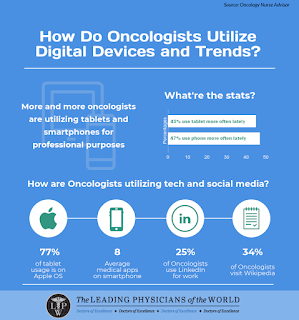Oncologist Use of Digital Tools
Advances in
wireless technology have given so many opportunities to the development of
mobile health platforms, also known as telehealth, telemedicine, eHealth, and
digital health. These amazing technologies offer a great opportunity for
healthcare providers to remotely deliver high-quality care. The possibilities
are endless for the clinical application of mHealth, including tools for
payers, decision support, patient support, educational purposes, drug
formularies, or medical uses.
Moreover, the number of smartphone owners currently using a mobile medical app is expected to increase to 3.4 billion by 2018. This shift will make patients the consumers of healthcare, empowering them to be the driving force managing their own health through mobile devices and wearable technology.
As
smartphones replace wallets, online banking, printed books, photo albums, and
cameras, mobile devices are beginning to reshape many medical functionalities.
In view of the fact that 83% of physicians are using smartphones and medical
apps to provide patient care, the traditional medical landscape is changing
dramatically, with the goal of delivering less expensive, but at the same time
high-quality care.
Mobile
health technology may improve access to specialized medicine, provide more
effective preventive care, increase monitoring of chronic conditions, and lead
to better patient outcomes in general. Most popular trends include wireless
patient monitoring, personal health record access via patient portals, mobilemedical devices, and virtual consultation. Health-related applications that are
currently in use include patient communication, access to Internet resources,
point-of-care documentation, disease management, educational programs,
professional communication, administrative functions, ambulatory services,
public health, and clinical trials. Moreover, the rapid development of mHealth
applications has expanded telehealth services to smartphones, tablets, and
laptops to deliver precision medicine to patients and families in the comfort
of their own home.
The FDA has
also approved imaging apps, allowing radiologists to interpret images or
ophthalmologists using color vision plates for clinical evaluation when a more
traditional viewing platform is not available. Digital images are a type of
store-and-forward technology, which permits the electronic transmission of
medical files that can be used at the convenience of providers to then make
diagnoses and recommendations and formulate treatment plans. As technology
advances on a daily basis, devices that provide real-time data monitoring and
biometric measurements can give healthcare providers immediate information to help
in clinical decision making.
While still
under development, Cicer, a monitor that tracks pulse, respiration, blood, and
oxygen through the use of predictive algorithms, can stream data to providers.
iTBra is currently being developed to help with the early detection of breast
cancer without requiring a mammogram. And Aira has developed wearable glasses
that stream live videos to agents who provide help with navigation and
assistance to patients who are blind or have low vision. These advancements
have the potential to revolutionize technology and medicine.
mHealth
could provide an opportunity for a new type of communication. The traditional
periodic patient visit has the potential to be combined with more frequent,
continuous digital communication for more effective care. This increased communication has the potential to complement the classic
approach and encourage patients to better understand their health and become
active participants in their care. A fully improvedmHealth system may result in
fewer physician visits, better symptom management, and decreased healthcare.




Comments
Post a Comment